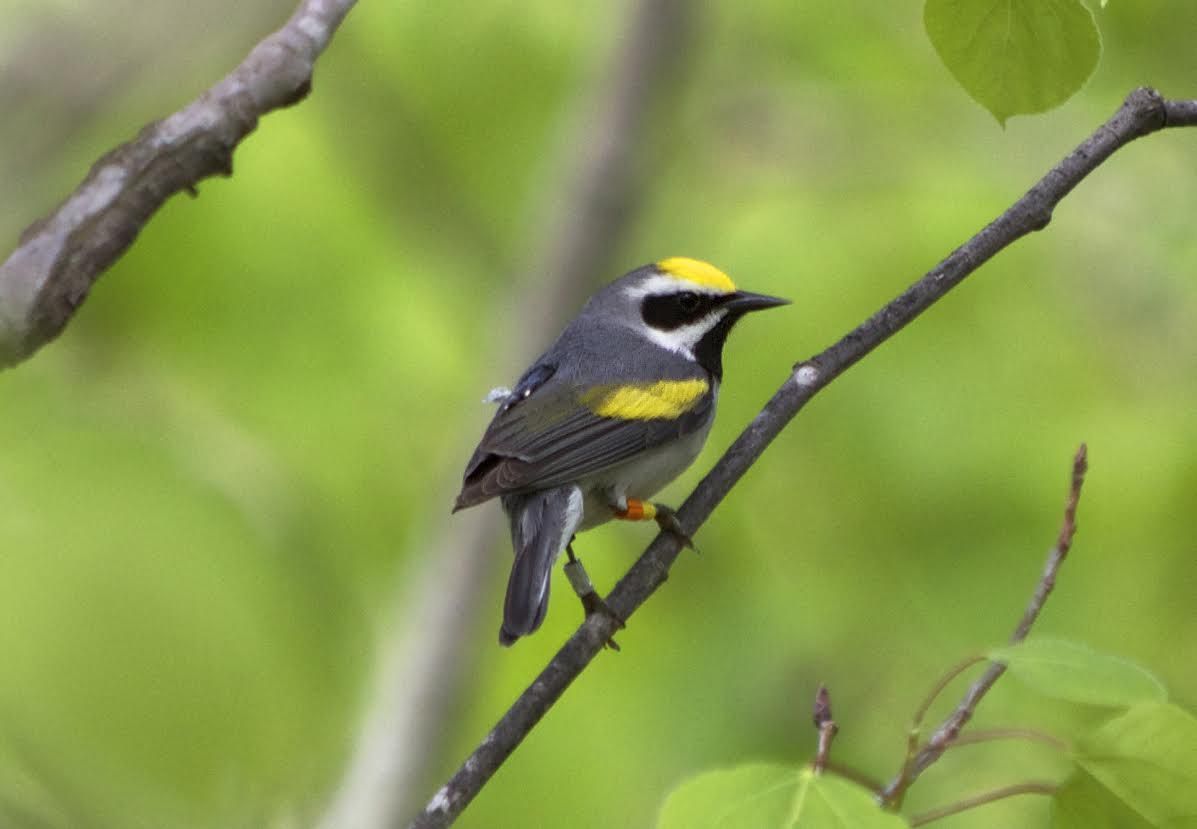
In late April of this year, an immensely powerful storm system swept through the Southern United States, spawning more than 80 tornadoes that killed 38 people. It was one of the worst tornado outbreaks in generations, causing $1 billion in damages.
About a year before, ornithologist Henry Streby and colleagues had outfitted 20 golden-winged warblers (Vermivora chrysoptera) with teeny-tiny geolocators to track the birds' location on their winter migration down to Colombia and then back to eastern Tennessee. The purpose of the project was in large part just to see if it was possible—nobody had put such sensors on birds this small.
The warblers, after all, "weigh a little more than three pennies and little less than two nickels," Streby says.
Luckily it worked, and didn't appear to impair the little birds' flying abilities. But when the researchers collected the birds' geolocators in May (from five individuals; the rest were lost) and began to analyze the data, they got a shock. It looked as if the birds left in late April—during the height of breeding season, when they definitely would not be expected to decamp—and flew hundreds of miles south, to the Florida panhandle and, in one case, Cuba.
As swiftly as they departed they came back to breed again, only five days later. All told, they'd traveled approximately 1,500 kilometers (930 miles), round-trip. At first Streby was convinced there was something wrong with the geolocators. "They're not supposed to do [this] kind of migration," he says.
But he and colleagues checked out the devices, and nothing seemed to be amiss. And indeed, though the birds flew along a route similar to the migration patterns that had been observed in the past, they didn't fly at exactly the same time or follow the same paths. The fact that all five geolocators reported a similar migration suggests to him the data, and mini-migration, are real, he says.
They then realized the trip had occurred around the same time as the storm. But not only that—the birds left one to two full days before we humans had seen any sign of it. When they began their travels, there was no change discernible in wind speed or direction, in barometric pressure or temperature. The birds had somehow known a very violent storm was coming, which might have killed them with its powerful winds or large hailstones.

It's been known for probably all of human history that birds are "fantastic weather prophets...they will leave early and get out of the way" of intense weather, says Jonathan Hagstrum, a research geophysicist with the U.S. Geological Survey in Menlo Park, California, who also studies birds. But this is the first time it's been shown scientifically so dramatically, says Hagstrum, who wasn't involved with Streby's research, published today in the journal Current Biology.
The question is, How?
Streby and Hagstrum think that the birds heard infrasound, very low-pitched noise, created by the massive storm. It has previously been suggested that some birds can hear sounds at as low a frequency as 0.05 hertz, Hagstrum says. By comparison, humans cannot usually hear sounds below about 20 hertz (or cycles of sound per second).
The idea the birds could pick up these low frequencies isn't new, and was suggested by the late Cornell ornithologist William Keeton in the 1960s. Hagstrum recently did some analysis of Keeton's work to show that homing pigeons use infrasound to help them navigate, says Frank Moore, a bird migration expert at the University of Southern Mississippi. But it hasn't been much studied.
This latest study by Streby and colleagues is yet more good evidence that birds can hear infrasound and use it to inform their migrations, notes Moore. "I think this makes me a believer in infrasound," says Moore, who wasn't involved in the study.
Infrasound is created by many natural phenomena, such as massive storms, waves crashing and even earthquakes (also, atomic weapons). "There's a complete world of infrasound we don't hear at all," Hagstrum says. And infrasound travels very, very far: Existing military infrasound detectors in the U.S. could, for example, pick up a nuclear bomb going off in Asia "without any problem," he says.
Alfred Bedard, a physicist at the Cooperative Institute for Research in the Environmental Sciences, has—from his perch in Colorado—detected infrasound from a storm more than 1,000 kilometers (620 miles) away.

Bedard confirmed that tornado-producing storms, like the massive outbreak in late April, indeed produce more infrasound than non-tornadic weather systems. In fact, he has shown in his work that infrasound arrays can be used to detect distant tornadoes before they are even reported by people on the ground or picked up by Doppler radar.
These new studies on infrasound are exciting and may open up a whole new field of study, Hagstrum says. He thinks birds may use infrasound not just to avoid hazards but as a "map" to help them navigate, on a regular basis. There are, for example, regular and reliable sources of infrasound, such as waves crashing on the beach, he says.
However, not everybody is convinced about birds hearing infrasound or the merits of this study. Sid Gauthreaux, an ornithologist at Clemson University, says the paper has serious problems. Specifically, Gauthreaux looked at the data on wind speed on the night of April 27, during which two of the birds are thought to have flown from eastern Tennessee to the Gulf Coast. He found that there were 20 to 30 mph southerly winds (meaning going to the north) on that night. Gauthreaux says he doesn't think it's possible for birds to fly that far against the wind.
"It's biologically so unlikely that I wonder if the geolocator information is not flawed in some way," he says. And he adds that the infrasound work is only speculation at this point.
Streby counters that the birds can indeed fly against these kinds of winds without a problem, he says.
The missing puzzle piece is that in the current study, the researchers didn't measure infrasound (not knowing, of course, that a storm would come). And thus, it isn't conclusive, says Phil Chilson, a professor of meteorology at the University of Oklahoma who also studies birds and wasn't involved in the research.
"But it's an interesting and highly plausible study...with a very cool result," Chilson says.
Uncommon Knowledge
Newsweek is committed to challenging conventional wisdom and finding connections in the search for common ground.
Newsweek is committed to challenging conventional wisdom and finding connections in the search for common ground.
About the writer
Douglas Main is a journalist who lives in New York City and whose writing has appeared in the New York ... Read more
To read how Newsweek uses AI as a newsroom tool, Click here.








